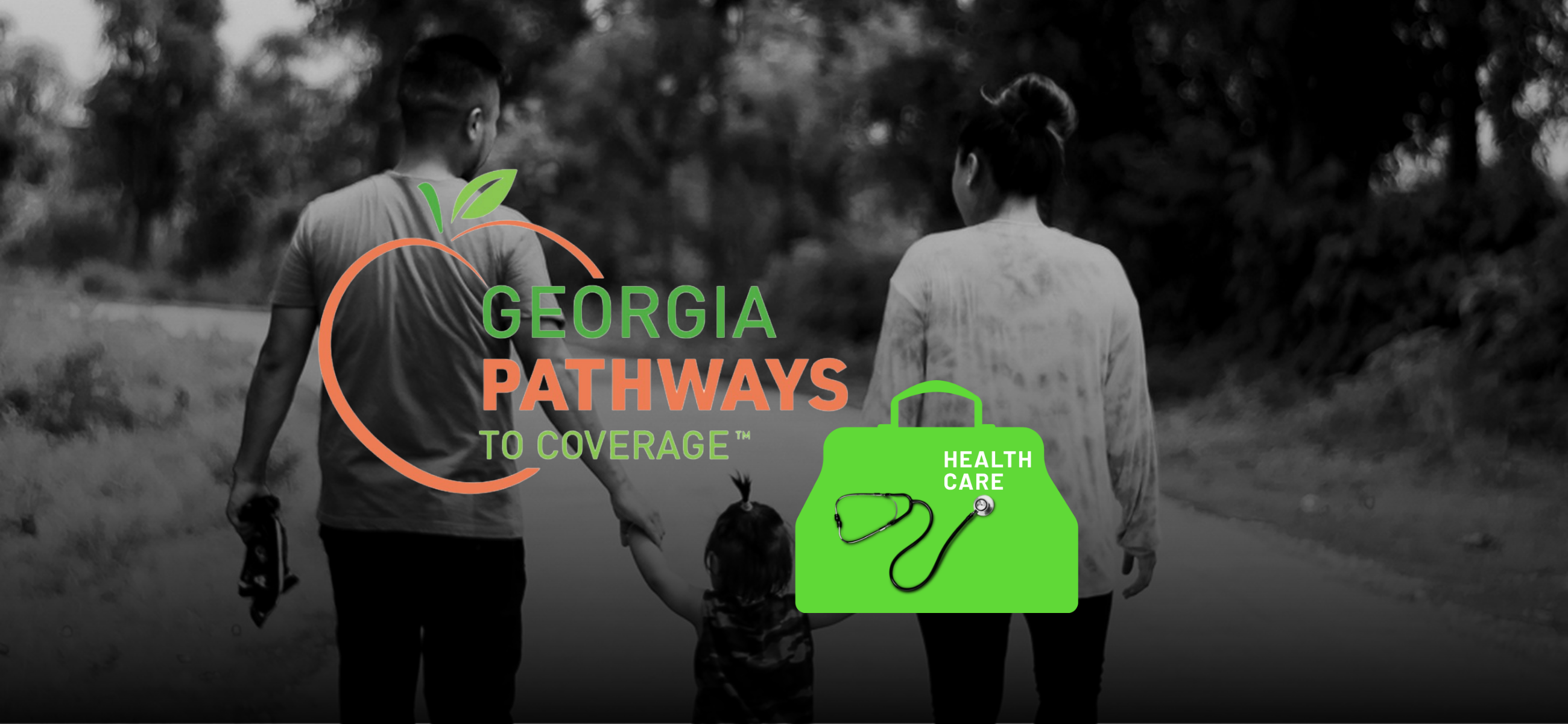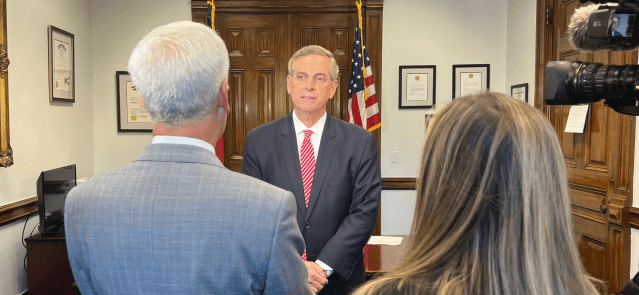Stay ahead of the curve as a political insider with deep policy analysis, daily briefings and policy-shaping tools.
Request a DemoGeorgia’s alternative to Medicaid expansion is complex, costly, experts say

(Credit: Georgia Department of Community Health; kabita darlami)
- Low signup so far for Georgia’s pilot work-for-Medicaid plan
- Program criticized for high costs, complexity and low reach
- Gov. Kemp determined to see Pathways plan succeed
Editor’s note: This is the second of a two-part series looking at two Medicaid-related topics in Georgia: “Medicaid unwinding” and Pathways to Coverage. To read Part 1 on Medicaid unwinding, go here. Pathways is Georgia’s work-for-Medicaid alternative to expanding Medicaid. This story looks at the Pathways program.
By now, state officials who oversee Georgia’s work-for-Medicaid program were projected to have about 100,000 people enrolled in Pathways to Coverage, the first of its kind in the country.
As of March 31, the most recent date for which data is available, 4,392 people had enrolled in the program, Gov. Brian Kemp’s alternative to expanding Medicaid. The bulk of those enrolled in Pathways are in the metro Atlanta area.
“We’re definitely falling short of those one-year enrollment projections,” Leah Chan, director of health justice at Georgia Budget and Policy Institute, told State Affairs.
The 11-month-old Pathways program was supposed to provide Medicaid to those who agreed to work or volunteer for 80 hours a month. Instead, Medicaid experts say, the program has proven to be a complex and costly venture.
“From our understanding, it’s a very complex process, not only to enroll, but demonstrating the right set of activities that qualifies you and reporting on it regularly,” said Jennifer Wagner, director of Medicaid eligibility and enrollment for the Center on Budget and Policy Priorities, a Washington, D.C.-based nonpartisan think tank. “It’s a burden on individuals trying to navigate a complex system to get the access to health care they need.”
Georgia taxpayers have spent $26 million on the pilot program, 90% of which has gone to administrative costs such as consultants, corporations and lawyers, Joan Alker, head of the Georgetown University Center for Children and Families, told State Affairs.
“It’s a failure,” Alker said. “It’s been a waste of taxpayer dollars. Very little is going to provide coverage.”
But Gov. Kemp, who unveiled the program last July, stands firmly behind it.
“Pathways is adding people, not taking away coverage. We’re adding people, and that is the spirit of Medicaid,” Kemp spokesman Garrison Douglas told State Affairs.
Now that the state is officially finished sorting through Medicaid eligibility, Douglas said the state can turn its full attention to Pathways.
“Our position remains the same. We’re going to continue to work to get Pathways in front of as many people as possible,” Douglas said. “We’re seeing incredible interest in the program.”
Pathways was supposed to start in July 2021 but was delayed due to the state’s legal fight with the Biden administration, which rescinded the federal government’s approval of the Pathways program.
At the start of 2022, Georgia sued the Biden administration, which refused to grant Georgia permission to force a work requirement as a condition to receiving Medicaid. The requirement had been approved under then-President Donald Trump. After several meetings, public hearings and other discussions, the federal government approved Pathways just before Christmas 2021.
In December 2022, Georgia officials told the Centers for Medicare & Medicaid Services — the federal agency that administers Medicaid, Medicare and children’s health insurance programs — that creating and launching an eligibility system would cost at least $51 million over two years.
Kemp still holds Joe Biden’s administration responsible for hampering Pathways’ launch.
“We’re going to continue to hold the Biden administration accountable for reclaiming the time that was stolen from us in regards to the implementation time for Pathways,” Douglas said, adding that Gov. Kemp is “determined to, now that we’re through that redetermination process, have the state’s additional resources to start processing [at a] faster rate those applications. Because, as I said, it’s not about a lack of interest; it’s about getting those applications processed.”
Douglas noted that information about the timetable for projected first-year enrollment is wrong. “We have always maintained that our projections were based off of a target date of 2025,” he said. “We have never provided quarterly or monthly projections for Pathways rollout.”
But Chan, of Georgia Budget and Policy Institute, told State Affairs that “the original estimate in the original sort of application for how many people would enroll in the first year was closer to about 30,000, and then the state had raised that estimate to up to 100,000.”
Last August, the institute launched a project to monitor the implementation of the first year of the Pathways to Coverage program. The project is not affiliated with the state.
Georgia Pathways to Coverage offers government health insurance to people earning up to the federal poverty level — $15,060 for an individual adult — if they can document that they’re working, in school or performing other qualifying activities. Georgia is one of 10 states that has not expanded Medicaid.
Pathways supporters say the program will better regulate the number of Georgians receiving Medicaid, which in turn will mean better care for patients because the system won’t be overloaded.
But one Medicaid expert says getting into Pathways and documenting such tasks can be overwhelming for some people.
“The burden of understanding if you qualify or not, and what you have to do to get on and stay on,” Wagner said. “That is just too much for a lot of families to overcome when they’re struggling with other challenges of being low-income families.”
Georgia has spent over $15.3 billion on Medicaid since 2018, Kemp told lawmakers last year.
Medicaid is available to Georgians who meet a variety of criteria. The federal poverty level for 2024 is $15,060 a year for one person, $20,440 a year for two people and $31,200 a year for a family of four.
With an estimated 1.4 million uninsured Georgians, the Peach State has the third-highest rate of uninsured people in the nation.
Find out more about Pathways to Coverage here.
Find out about Georgia’s Medicaid system here.
Read Part 1 of this series here.
Have questions, comments or tips? Contact Tammy Joyner on X @lvjoyner or at [email protected].
Newly minted Senate Minority Leader Harold Jones II: ‘I’m not the typical back-slapping politician’
Nearly 10 years into legislative life, Sen. Harold Jones II wouldn’t change anything about the experience. “I love every minute of it. Even when I hate it, I love it,” the 55-year-old Augusta Democrat told State Affairs. Come January, Jones will add another role to his legislative duties: Senate minority leader, a job held for …
Gov. Kemp calls on state agencies to be fiscally restrained amid record $16.5B surplus
The Gist Gov. Brian Kemp asked the state’s 51 government agencies for continued fiscal restraint when drafting their amended fiscal year 2025 and 2026 budgets. Most agencies adhered to his request even as the state’s general fund surplus hit a record $16.5 billion last month. Forty-five agencies, excluding state courts, followed the governor’s instructions to …
Georgia defies bomb threats as election chief declares a “free, fair and fast” vote amid record turnout
ATLANTA – Despite dealing with over 60 bomb threats, Georgia’s election chief said Tuesday the state’s general election went smoothly. Georgia had a record turnout with nearly 5.3 million people voting, Secretary of State Brad Raffensperger told reporters. Election officials in the state’s 159 counties have until 5 p.m. to certify votes. “We had a …
In the (state)house: Meet the newest members of the Georgia legislature
When lawmakers reconvene at the state Capitol on Jan. 13, there’ll be a cadre of new faces in the 236-member Georgia General Assembly, one of the nation’s largest state legislatures. All 236 statehouse seats were up for election this year. Most candidates ran unopposed. Incumbents in contested races easily kept their seats, with the exception …




